Catholic Customs
 |
 |
 |
 |
 |
 |
 |
The Third Day of Christmas:
The Wine of St. John
The third day of Christmas brings the Feast of the most beloved Apostle. With what love and devotion did Catholics of old honor St. John on his feast day!
So grand is his vocation that Catholics of the East have the belief that St. John did not die because of the words that Our Lord spoke about him: "If I wish him to remain until I come, what is it to thee?" (Jn 21, 23).
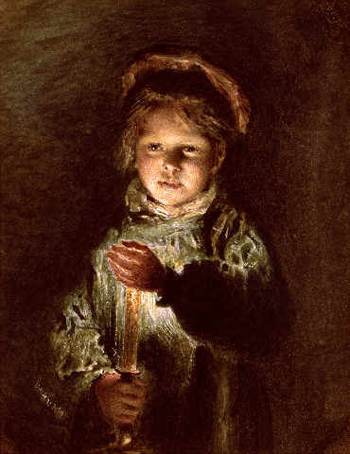 In the early centuries, many pilgrims who visited his tomb in Selcuk, Turkey, told stories about the earth on top of his grave moving up and down with each breath that the Saint took in his deep sleep. Some believe that St. John was taken up to Heaven after "sleeping" in his tomb for several years. (1)
In the early centuries, many pilgrims who visited his tomb in Selcuk, Turkey, told stories about the earth on top of his grave moving up and down with each breath that the Saint took in his deep sleep. Some believe that St. John was taken up to Heaven after "sleeping" in his tomb for several years. (1)
Boys bearing the Saint’s name were inspired with noble sentiments when the feast of their patron arrived on December 27. In the Finnish town of Merikarvia, boys named Jussi (Finnish for John) bought candles to burn at their parish church in honor of St. John. (2) In central Europe, boys named John were given the privilege of lighting the Christmas candles and the candles on the Christmas tree on this feast day to honor the Saint who proclaimed so profoundly the glories of Him Who is "the true Light, which enlighteneth every man that cometh into this world" (John 1:9). (3)
Medieval Catholics felt such an intimacy with the Apostle of Love that no celebration in his honor could be complete without a ceremonial wine to honor that love. St. John’s love of Our Lord reached its height as he leaned his head on the breast of Our Lord at the Last Supper and drank of the sacred Chalice of His Blood. Inspired by this mystery, Catholics saw wine as a fitting symbol of the feast.
Drinking to the love of St. John
Every Medieval household brought their finest wine from their cellars to have it blessed in honor of St. John. The wine was given the name of the "Love of St. John" (Johannesminne), and every member of the household received at least a sip of it during the meal on December 27 as a sign of unity with St. John. In some areas, the wine was served warm with spices and sugar. (4)
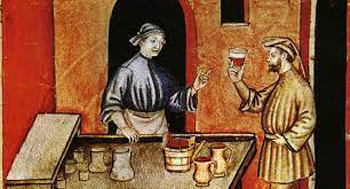
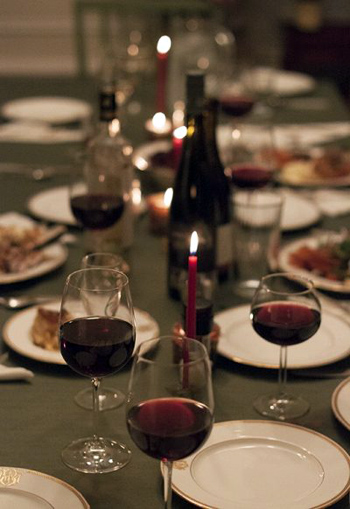 The father of the family led this solemn ceremony by blessing the cup of wine and passing it to all of the family members, who each each exclaimed, "I drink to the love of St. John" as they sipped from the cup.
The father of the family led this solemn ceremony by blessing the cup of wine and passing it to all of the family members, who each each exclaimed, "I drink to the love of St. John" as they sipped from the cup.
Maria von Trapp describes the solemn way in which this ceremony was performed in Austria:
"Just before the meal begins, everybody stands up, holding his glass, while the father and mother begin the St. John's Day ceremony: The father touches the mother's glass with his glass, looks her in the eyes and says, ‘I drink to you the love of St. John.’ The mother answers, ‘I thank you for the love of St. John,’ and they both take a sip. Then the mother turns to the oldest child and repeats [the words] and the child answers, ‘I thank you for the love of St. John.’
“Again they take a sip and the child turns to the next oldest, and so it goes around the table until the last one turns to the father and the family circle is closed." (5)
Catholics from central Europe still continue to bring their wine and cider to the church to be blessed on this day. In some areas of Germany, the priest offers the wine to the faithful after Mass with the words, "Drink the love of St. John, in the name of the Father †, the Son † and the Holy Spirit † Amen," and all of the people drink of the sacramental inside the church. (6) What a beautiful symbol this is of Catholic unity!
The power of St. John’s wine over evil
The traditional words of the blessing from the Roman Ritual show the efficacy of this great sacramental that has the power to preserve men from the effects of poison:
Bless and consecrate, O Lord God, this chalice of wine through the merits of St. John, Apostle and Evangelist. Bestow benediction and protection upon all who drink of this cup. For as the Blessed John partook of the poisoned potion without any hurt, so may all who on this day drink of the blessed wine to the honor of St. John, by him be freed from poisoning and similar harmful things. And as they offer themselves soul and body to thee, O Lord God, give them absolution and pardon. Through Christ our Lord. Amen.
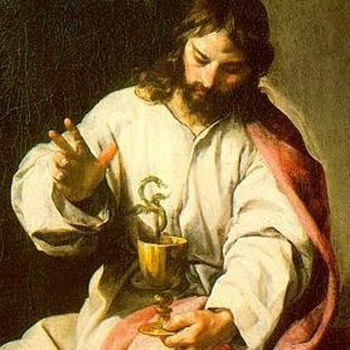 As the words of the blessing clearly intimate, the "Love of St. John" is not only symbolic of the sacred chalice of the Last Supper, but also commemorates a miracle of St. John.
As the words of the blessing clearly intimate, the "Love of St. John" is not only symbolic of the sacred chalice of the Last Supper, but also commemorates a miracle of St. John.
According to the Golden Legend, Aristodemus, the high priest of Diana, strove to incite the populace against John and cause his death. To obtain this end, Aristodemus offered a cup of poisoned wine to St. John declaring that if the Apostle could drink this poison unharmed, then he would convert to Christianity.
St. John took the cup, blessed it, and drank without feeling any ill effect. Some legends recount that the poison rose out of the chalice in the form of a serpent after St. John blessed it. This miracle is often depicted with St. John holding a cup out of which a snake slithers.
This miracle has caused Catholics to treasure every last drop of their St. John's wine. Catholic families stored a portion of the wine in a special place in their house to be brought out to drunk on different occasions throughout the year.
To every wine barrel in the wine cellar a drop of St. John's wine was added in order to ensure that the wine would not spoil. In Medieval England, little loaves of bread called manchets were baked using some of St. John's wine in the dough, and these loaves were believed to give the same blessings and protection as the wine itself. (7)
After a wedding, the bridegroom and bride were each given a sip of St. John's wine to drink to each other the "love of St. John" and bring blessings on their marriage. Sick family members were given a sip of the wine in hopes that it would revive their health.
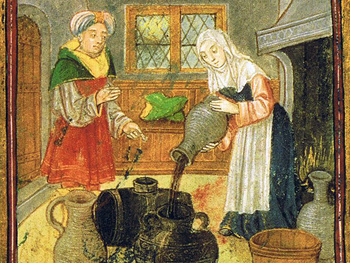 Travelers departing on a long journey also took a sip of the wine so that the sacramental would preserve them on their way and return them safe to their homes. In some ceremonies, the departure of a family member was taken so seriously that a drop of St. John's wine was placed in every glass so that all could drink the "love of St. John" and pray that it would not be broken by unexpected tragedy on the journey.
Travelers departing on a long journey also took a sip of the wine so that the sacramental would preserve them on their way and return them safe to their homes. In some ceremonies, the departure of a family member was taken so seriously that a drop of St. John's wine was placed in every glass so that all could drink the "love of St. John" and pray that it would not be broken by unexpected tragedy on the journey.
Just as St. John’s wine brought consolation during the most important events of a Catholic’s life, so it did again as death drew near, reminding the dying man of all of the blessings that he had received through the intercession of this great Saint. After receiving Extreme Unction, the dying man was given a sip of St. John’s wine that imparted to him strength to face the terrors of death and to make that great leap from earth to eternity.
What a glorious tribute St. John gives to the new born Babe on this his feast day! Let us unite with him in giving due honor to the feast of Christmas by celebrating its octave with ceremony, joy and merriment. How wonderful if Catholic peoples once again would ask the priests to bless their wine in honor of the great Saint "who leaned upon the Lord's breast at the Supper." (8)
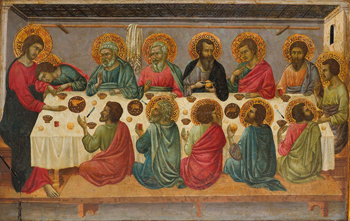

Posted December 26, 2022
So grand is his vocation that Catholics of the East have the belief that St. John did not die because of the words that Our Lord spoke about him: "If I wish him to remain until I come, what is it to thee?" (Jn 21, 23).

Boys with the name John were privileged to light the candles on this day
Boys bearing the Saint’s name were inspired with noble sentiments when the feast of their patron arrived on December 27. In the Finnish town of Merikarvia, boys named Jussi (Finnish for John) bought candles to burn at their parish church in honor of St. John. (2) In central Europe, boys named John were given the privilege of lighting the Christmas candles and the candles on the Christmas tree on this feast day to honor the Saint who proclaimed so profoundly the glories of Him Who is "the true Light, which enlighteneth every man that cometh into this world" (John 1:9). (3)
Medieval Catholics felt such an intimacy with the Apostle of Love that no celebration in his honor could be complete without a ceremonial wine to honor that love. St. John’s love of Our Lord reached its height as he leaned his head on the breast of Our Lord at the Last Supper and drank of the sacred Chalice of His Blood. Inspired by this mystery, Catholics saw wine as a fitting symbol of the feast.
Drinking to the love of St. John
Every Medieval household brought their finest wine from their cellars to have it blessed in honor of St. John. The wine was given the name of the "Love of St. John" (Johannesminne), and every member of the household received at least a sip of it during the meal on December 27 as a sign of unity with St. John. In some areas, the wine was served warm with spices and sugar. (4)

Drinking to the ‘love of St. John’ –
a symbol of unity from medieval times

Maria von Trapp describes the solemn way in which this ceremony was performed in Austria:
"Just before the meal begins, everybody stands up, holding his glass, while the father and mother begin the St. John's Day ceremony: The father touches the mother's glass with his glass, looks her in the eyes and says, ‘I drink to you the love of St. John.’ The mother answers, ‘I thank you for the love of St. John,’ and they both take a sip. Then the mother turns to the oldest child and repeats [the words] and the child answers, ‘I thank you for the love of St. John.’
“Again they take a sip and the child turns to the next oldest, and so it goes around the table until the last one turns to the father and the family circle is closed." (5)
Catholics from central Europe still continue to bring their wine and cider to the church to be blessed on this day. In some areas of Germany, the priest offers the wine to the faithful after Mass with the words, "Drink the love of St. John, in the name of the Father †, the Son † and the Holy Spirit † Amen," and all of the people drink of the sacramental inside the church. (6) What a beautiful symbol this is of Catholic unity!
The power of St. John’s wine over evil
The traditional words of the blessing from the Roman Ritual show the efficacy of this great sacramental that has the power to preserve men from the effects of poison:
Bless and consecrate, O Lord God, this chalice of wine through the merits of St. John, Apostle and Evangelist. Bestow benediction and protection upon all who drink of this cup. For as the Blessed John partook of the poisoned potion without any hurt, so may all who on this day drink of the blessed wine to the honor of St. John, by him be freed from poisoning and similar harmful things. And as they offer themselves soul and body to thee, O Lord God, give them absolution and pardon. Through Christ our Lord. Amen.

St John with the poisoned cup and serpent
According to the Golden Legend, Aristodemus, the high priest of Diana, strove to incite the populace against John and cause his death. To obtain this end, Aristodemus offered a cup of poisoned wine to St. John declaring that if the Apostle could drink this poison unharmed, then he would convert to Christianity.
St. John took the cup, blessed it, and drank without feeling any ill effect. Some legends recount that the poison rose out of the chalice in the form of a serpent after St. John blessed it. This miracle is often depicted with St. John holding a cup out of which a snake slithers.
This miracle has caused Catholics to treasure every last drop of their St. John's wine. Catholic families stored a portion of the wine in a special place in their house to be brought out to drunk on different occasions throughout the year.
To every wine barrel in the wine cellar a drop of St. John's wine was added in order to ensure that the wine would not spoil. In Medieval England, little loaves of bread called manchets were baked using some of St. John's wine in the dough, and these loaves were believed to give the same blessings and protection as the wine itself. (7)
After a wedding, the bridegroom and bride were each given a sip of St. John's wine to drink to each other the "love of St. John" and bring blessings on their marriage. Sick family members were given a sip of the wine in hopes that it would revive their health.

A drop of blessed wine was added to each barrel
Just as St. John’s wine brought consolation during the most important events of a Catholic’s life, so it did again as death drew near, reminding the dying man of all of the blessings that he had received through the intercession of this great Saint. After receiving Extreme Unction, the dying man was given a sip of St. John’s wine that imparted to him strength to face the terrors of death and to make that great leap from earth to eternity.
What a glorious tribute St. John gives to the new born Babe on this his feast day! Let us unite with him in giving due honor to the feast of Christmas by celebrating its octave with ceremony, joy and merriment. How wonderful if Catholic peoples once again would ask the priests to bless their wine in honor of the great Saint "who leaned upon the Lord's breast at the Supper." (8)

St. John ‘who leaned upon the Lord's breast at the Supper’
- Francis X Weiser, The Holyday Book (London: Staples Press Limited), p. 140.
- http://urhoklubi.net/Vanhan_kansan_suusta.htm#Mikkeli
- Weiser, The Holyday Book, p. 141.
- Evelyn Birge Vitz, A Continual Feast (San Fransisco: Ignatius Press, 1985), p. 157.
- Maria Augusta Trapp, Around the Year with the Trapp Family (New York: Pantheon Books, 1955), p. 64.
- http://www.brauchtumsseiten.de/a-z/j/johanneswein/home.html
- https://www.thebookofdays.com/months/dec/27.htm
- From the Versicle after the Vesper Hymn for the feast of St. John, translation found in The Liturgical Year, Vol II, p. 261

Posted December 26, 2022
______________________
______________________
 |
 |
 |
 |
 |
 |


